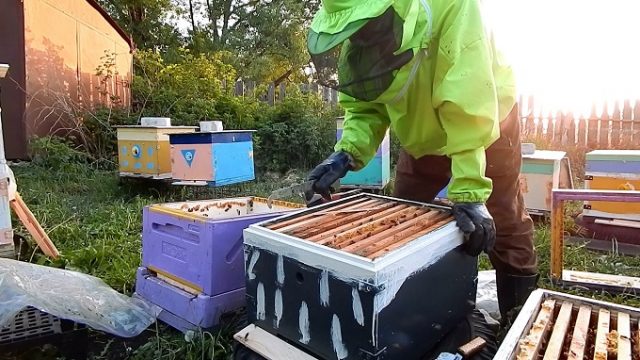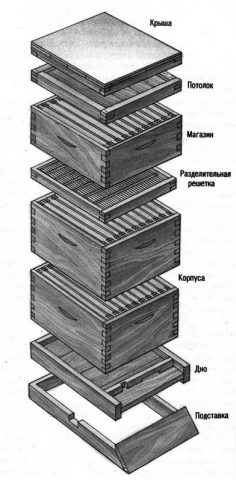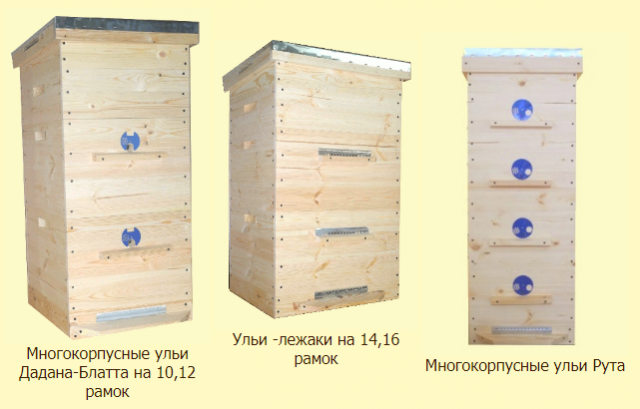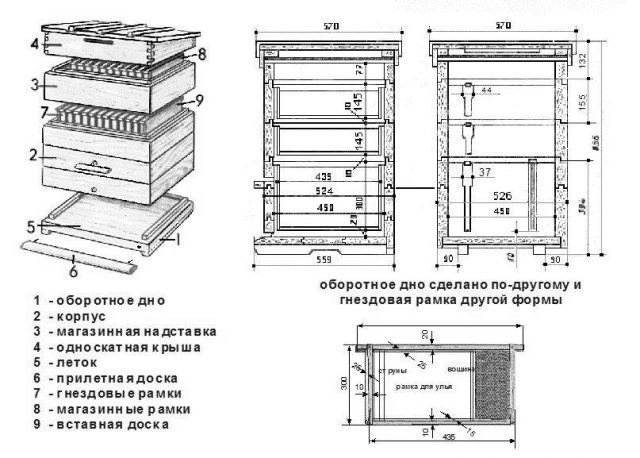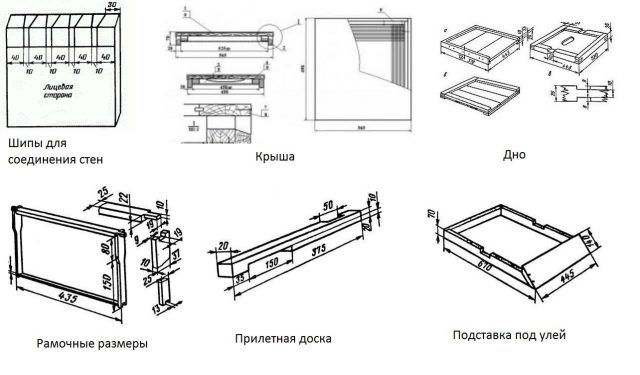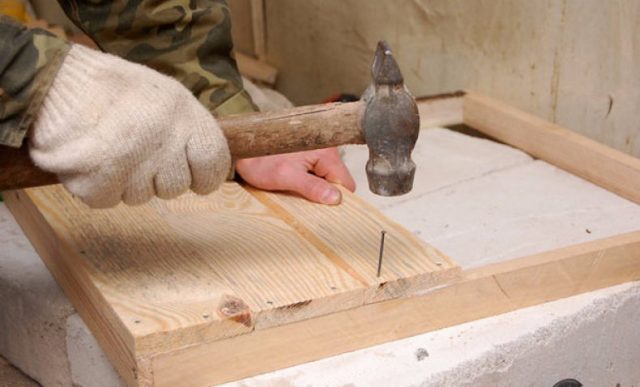Content
Keeping bees in multi-body hives allows you to save space in the apiary and receive large bribes. For the beekeeper, the very process of caring for families is simplified. Multi-hull houses consist of interchangeable housings. This is one of the important advantages of the technology. The sections can be easily swapped if necessary.
Benefits of multi-hull beekeeping
The dwelling of the bees should be convenient for the insects themselves and the beekeeper serving them. In multi-hive hives, each beekeeper determines the pros and cons from his point of view. However, many avid hobbyists highlight more benefits:
- By placing each body on top of each other, the space occupied by the apiary is reduced. Most often, beekeepers collect 4-box hives, but there may be a different number of tiers.
- Multi-hull keeping allows dividing the bee dwelling into zones of different functionality. The best conditions are created for the reproduction of the bee colony, and the increase in honey yield.
- The multi-body hive model resembles a constructor. The beekeeper is given the opportunity to change their places and arrange the sections at his own discretion.
- Each hive body is lightweight. They are easy to rearrange, carry, maintain alone.
Of the minuses, only the large weight of the multihull structure can be noted, if it is transferred as a whole, and not in sections.
Features of the device of multi-hive hives
The multi-body analog differs from a single-body hive only in the number of sections. They are all identical for each model and are interchangeable.
Externally, multihull hives resemble a column. The structure consists of the following elements:
- The body is made of planks, reminiscent of a rectangular box. The size depends on the model and the number of frames. The body is equipped with a tap hole.
- The bottom of the hive is stationary and removable. The shield is similarly assembled from a 35 mm thick board.
- The roof is usually made flat with a slight slope. The shield is assembled from the boards, and sheathed with galvanized or aluminum on top.
- The roof cover is placed between the roof and the upper part of the body. Sometimes the element is partitioned off.
- The hive ceiling is assembled from a thin board. Two stripes are used to connect. The element is the horizontal diaphragm between the compartments.
- The ventilation grill is a frame with a stretched fine mesh. The installation site of the element is the roof, liner folds or the body.
The variety of multi-housing houses is great. The most popular are the Dadan-Blatt and Langstroth-Root models. Hives are vertical and sun loungers.
Fans of Canadian technology for keeping bees prefer Mishak's multi-hive hives, which differ in size and special design. The alpine hive, created by the beekeeper Roger Delon, seems unusual at first glance.
How to make a DIY multi-hive hive
First of all, a novice beekeeper needs drawings of a multi-hive hive, if an idea has come to make houses on his own. Before looking for a scheme, you need to decide in advance how many frames you need a construction for. The most popular are hives for 10, 12 and 14 frames.
Drawings, materials, tools
A novice beekeeper needs to know that to assemble a multi-body hive with his own hands, drawings can be taken of one model for any number of frames, for example, 10 frame Dadan. According to this scheme, you can make a house for a different number of frames. The general scheme is the same, only the sizes differ.
Of the materials, you will need a dry board 35 mm thick. Optimal use of coniferous wood, willow, linden. To connect the boards to each other with a thorn-groove lock, PVA glue is used, which provides a better sealing of the seams. The walls are pulled together with self-tapping screws or knocked down with nails.
From the tool you need a saw, a router, a plane, a hammer, a set of chisels, sandpaper or a grinder.
Build process
Do-it-yourself multi-body hives start from the body. The board is dismissed into blanks, adhering to the dimensions of the drawing. Since the wood will still be sanded, an allowance of about 3 mm is left. For facing, the parameter is increased to 10 mm.
On the sides, the elements of the lock connection are cut. There is a spike on one side and a groove on the other. During the wash, it is important to observe straightness, otherwise the wall of the hive will turn out to be distorted. The workpieces are thoroughly ground. The assembly is carried out with gluing the lock joint with glue. Using different widths of the boards when assembling the boards, the walls of the case are folded so that the seams do not coincide. The spacing of the joints will provide structural strength. At the corners, the walls of the case are pulled together with self-tapping screws.
On the inside of the hive, in the upper part of the front and rear walls, folds are equipped with a width of 11 mm and a depth of 17 mm. The frame should become folds into folds so that there is a 7 mm difference in height between the upper bar and the edge of the case. Clearance is required for installation on top of the next chassis. From the outside, in the center of the side walls of the case, transport handles are attached.
For the roof, a shield is knocked down from boards 25 mm thick. The top is sheathed with sheet metal. About four ventilation holes are drilled into the roof.
It is advisable to make the bottom removable to make it easier to clean the hive. The structure is assembled from the board, the harness is attached. The back and side rails are solid. A notch is cut on the front element of the harness. Here, a 50 mm wide ledge is arranged, which forms an arrival board.
When all parts of the hive are ready, they are combined into a single multi-body structure. Outside, the house is painted to protect the wood from destruction.
Setting up hives
According to the rules for keeping bees, multi-body and single-body hives should not be placed on the ground. First, the wooden bottom quickly disappears. Secondly, bees will be cold in winter, damp during rain, and hot in summer. Special stands are made for hives. At home, you can use brick or cinder block. For a nomadic apiary, metal folding stands are usually made.
Rules for keeping bees in multi-body hives
In the period from spring to autumn, work with multi-hull hives Dadan, Ruta or other models, with the exception of some nuances, is almost the same, as is the maintenance of single-hull houses. The main difference is overwintering. Strong colonies of bees are moved to separate single-storey hives. For the survival of weak bee colonies, they are put on top of each other in the enclosures.
The video tells about the content of bees:
How to form layering
Keeping bees in a multi-tiered house simplifies the process of forming layers. The beekeeper divides the body with a ceiling diaphragm. With the beginning of the season, the uterus is placed in the upper compartment, where it will begin to lay eggs and hatch the young. During the honey harvest, the formed cuttings are connected to the main family of bees.
Increase in bee colonies
To increase the number of bees in a multi-hive hive, the queen must be provoked into increased egg deposition. The beekeeper moves the compartment with the queen to the very bottom of the multi-hull house. The instinct will push the uterus to move upward and at the same time to brood.
The procedure is carried out warmly in early May. Brood emergence is expected by the beginning of flowering of acacia. An empty housing is inserted between the inhabited compartments of the hive to prevent swarming of bees. Large free space will create optimal conditions for the growth of the family.
Rearrangement rules
Keeping bees in a multi-hull house requires periodic rearrangement of the hulls. The procedure helps to strengthen the bee colony, to avoid swarming. There is no exact date when it is necessary to rearrange the hulls. Each beekeeper maintains a calendar of observations for himself, draws up a schedule for replacing frames and installing new sections in a multi-tiered hive. The process depends on the amount of honey collection, the duration of flowering, the weather conditions of the area, the location of the apiary.
Wintering
The main difference between the content of bees in a multi-hive hive is observed in winter:
- Strong colonies of bees are moved to separate single-tier hives for the winter. Weak colonies are left in multi-tiered dwellings.
- In a multi-tiered hive, where weak colonies are left for maintenance, a compartment with bees and brood is located in the lower tier. On the upper tiers, frames with food filled with honey and pollen are fixed.
- While eating the food supplies, the bees will gradually move to the upper compartments. The lower empty body is removed after the onset of heat.
After wintering, the bees are examined, the condition of the queen is checked. Based on the results of the check, further actions are planned.
Conclusion
Keeping bees in multihull hives is beneficial for nomadic and stationary apiaries. In addition to saving space on the site, fewer materials are required for the manufacture of houses, since the roof and bottom of several buildings are common.
